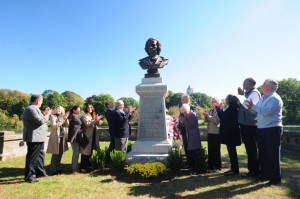17 Oct ESSEX COUNTY EXECUTIVE DIVINCENZO DEDICATES MENDELSSOHN BUST IN ESSEX COUNTY BRANCH BROOK PARK PRUDENTIAL CONCERT GROVE Refurbished Bronze Bust and Granite Pedestal are Returned to Branch Brook Park after being held in Storage for 40 Years
Published on October 17, 2017
Newark, NJ – Essex County Executive Joseph N. DiVincenzo, Jr. dedicated the refurbished Mendelssohn Bust in its new location in the Prudential Concert Grove in Essex County Branch Brook Park on Tuesday, October 17th. The bronze statue, which had been removed from its original perch about 40 years ago, is the latest historical feature of the park to be restored as part of the County Executive’s ongoing initiative to revitalize the historic Essex County Parks System.
“We are pleased to have restored this treasure and returned it to Branch Brook Park where it belongs. It’s a part of our history and culture, and feels good to be able to share it again with the public to view and enjoy,” DiVincenzo said. “Its placement in the Prudential Concert Grove is fitting because it reconnects the statue with its musical history with the park,” he noted.
In the spring of 2017, DiVincenzo commissioned sculptor Harry Gordon from Lambertville to refurbish the bronze bust of Mendelssohn and the granite pedestal. The 20-ton pedestal was removed from its original location along the east side of the lake in Branch Brook Park behind Barringer High School. Gordon smoothed scratches and dents on the bronze bust and cleaned graffiti from the granite pedestal. It was re-installed on the west side of the lake in the Prudential Concert Grove in the Southern Division of Branch Brook Park. The back of the statue is to the lake, with the Mendelssohn Bust looking toward the concert grove and meadow. The preservation work was funded with a grant from the Essex County Recreation and Open Space Trust Fund.
Local officials and community members welcomed the return of the Mendelssohn Bust to the landscape of Branch Brook Park.
“This is an example of how our County Executive goes about restoring the parks while respecting history and connecting it to the present,” NJ State Senator and Deputy Chief of Staff Teresa Ruiz said.
“We are so pleased the County Executive had the statue restored. It is another example of how we are continuously making our open spaces even better,” said Freeholder Patricia Sebold, who was joined by Freeholder Len Luciano.
“This is another reason that makes Branch Brook Park so special,” Sheriff Armando Fontoura said.
“I commend the County Executive for preserving this story of people who came to Newark, made the city better and loved Branch Brook Park. You have added to the mosaic of our community,” said historian Liz Del Tufo.
Branch Brook Park Alliance Co-President Barbara Bell Coleman thanked DiVincenzo for “bringing Mendelssohn back and giving him a new home. The bust is now close to people and adds to the historic texture and history of the park.”
During the dedication ceremony, members of the Saengerchor Newark and the Schwaebischer Saengerbund, two German singing groups, performed the song “Der Ruf nach Frieden” (The Call for Peace). These groups descended from the United Singers of Newark, which received the Mendelssohn Bust as a prize. “Thank you for bringing this statue back to life and for putting it in such a prominent and beautiful location,” said Fred Paul, who served as the last president of the United Singers of Newark and is a current member of the Saengerchor Newark and the Schwaebischer Saengerbund.
The bronze bust of Mendelssohn was won by the United Singers of Newark at a regional singing festival, or Sängerfest, hosted by the Nordoestlicher Saengerbund von Amerika in Baltimore in 1903. There were over 6,000 singers in the contest, which was attended by President Theodore Roosevelt. The group, comprised of 13 men’s choruses from Newark, took first place in the competition with their rendition of “Hochamt Im Walde” (The Woodland Mass) by R. Becker and conducted by Julius Lorenz. The winning prize for groups with at least 200 members was the bronze bust of German composer Felix Mendelssohn, which was created by the Baltimore sculptors Joseph M. Didusch & Son and cast at the Roman Bronze Works foundry in New York City. Upon returning to Newark late at night, the group was welcomed by hundreds of fans at Penn Station who paraded to the Krueger Auditorium in Newark’s Springfield/Belmont neighborhood, which was populated with predominately German residents, for a celebration.
In the following months, the group campaigned to have the bust installed in Essex County Branch Brook Park. A site on the eastern side of the lake that featured a promenade and formal garden was chosen and the bust was dedicated on May 23, 1904, with thousands on hand to witness it. The United Singers paid for the pedestal and installation.
Generations later, a new Barringer High School was constructed on the eastern side of the lake in the area of the promenade and gardens. This made the Mendelssohn Bust less visible and harder for the public to access. When the statue started to become vandalized, the bronze bust was removed from the pedestal for safe keeping by members of the Essex County Parks Commission. The bust was occasionally displayed in the lobby of the Parks Administration Building at 115 Clifton Avenue in Newark until about 1998. Since then, it had been stored in the Parks Maintenance Building off Heller Parkway.

